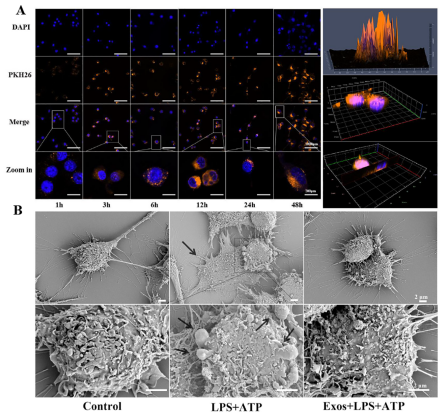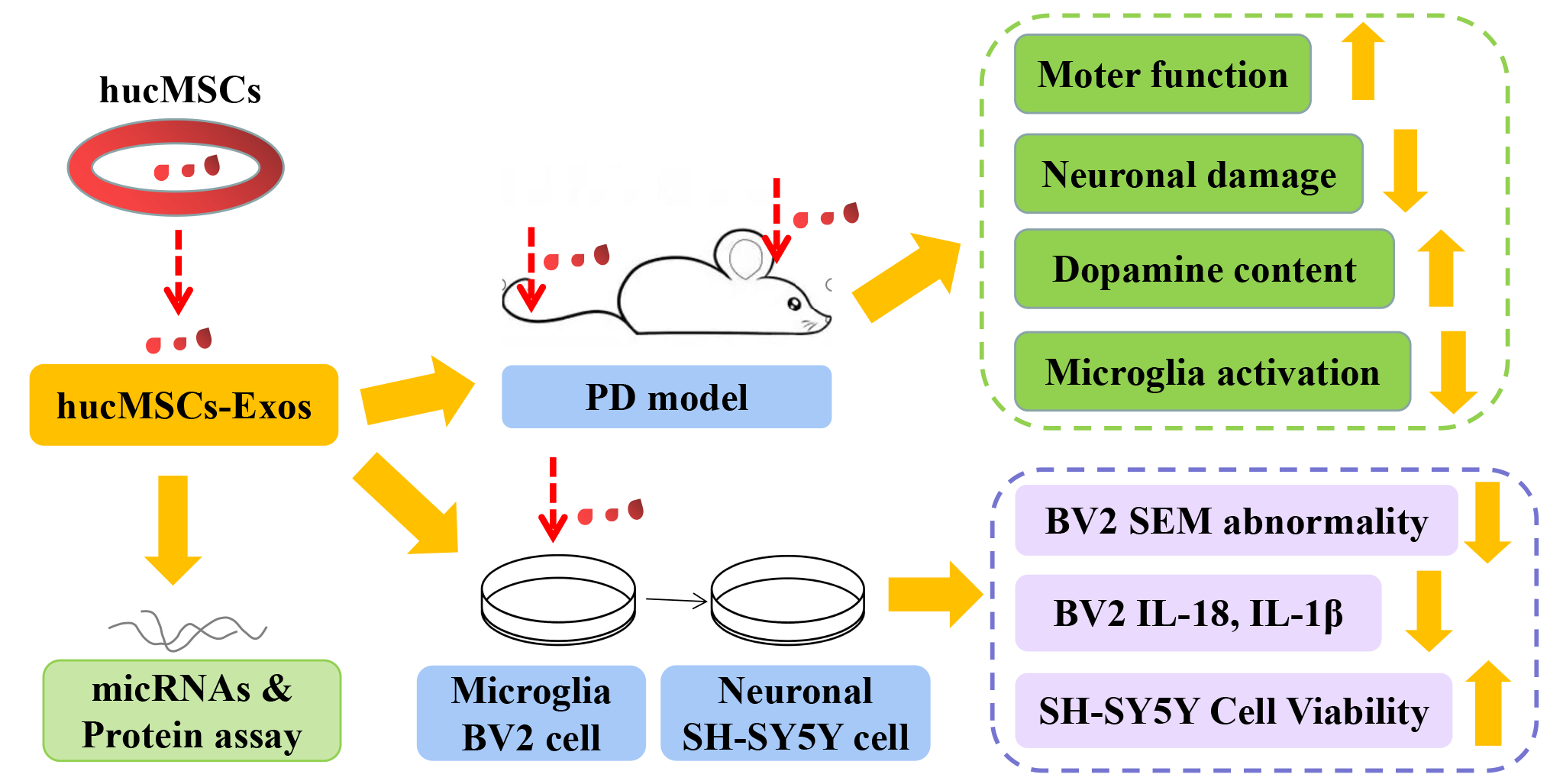NRR:河北医科大学柴锡庆和河北中医学院安胜军团队揭示人脐带间充质干细胞源外泌体用于治疗帕金森病的潜力
撰文:张忠霞,柴锡庆,安胜军
帕金森病(Parkinson’s disease, PD)是以运动障碍为主要表现的第二大神经退行性疾病,其发病及疾病的进展与小胶质细胞介导的神经炎症、细胞焦亡密切相关。人脐带间充质干细胞作为来源充足、免疫原性最低的间充质干细胞之一,已证实能够改善PD动物模型的行为学表现及PD患者的临床症状[1,2],但其在维持活性、有效物质定量、穿越血脑屏障等方面存在相对局限性。人脐带间充质干细胞来源的外泌体(human umbilical cord mesenchymal stem cells derived exosomes, hucMSCs-Exos)是细胞外囊泡中直径最小(30-150 nm)的一类纳米级物质,包含干细胞的多种基因、蛋白,可以作为载体将目的蛋白、RNA转运至受体细胞内部,其在无细胞治疗方法中的应用具备优势 [3]。尽管已有报道hucMSCs-Exos可以通过抑制炎症治疗肝损伤[4]、糖尿病大鼠视网膜炎[5],修复缺血性损伤[6],而其是否能通过抑制小胶质细胞来保护神经元进而改善PD症状还未可知。
近期,河北医科大学的柴锡庆和河北中医学院的安胜军团队在《中国神经再生研究(英文版)》(Neural Regeneration Research)上发表了题为“Exosomes derived from human umbilical cord mesenchymal stem cells alleviate Parkinson's disease and neuronal damage through microglia inhibition”的研究论文。该研究hucMSCs-Exos可以穿越血脑屏障,明显抑制帕金森病小胶质细胞的激活,缓解帕金森病的运动障碍,减轻多巴胺能神经元的损伤。进一步研究证实,hucMSCs-Exos可以被小胶质细胞摄取,明显改善小胶质细胞介导的神经元损伤,可能是通过其含有的microRNAs或蛋白抑制小胶质细胞的焦亡来实现的。对于hucMSCs-Exos功能的探究,为临床帕金森病及其他与炎性相关的神经系统疾病的治疗提供了更广阔的思路。
目前的研究已显示,帕金森病与小胶质细胞介导的炎性反应有关,间充质干细胞来源的外泌体在其他疾病的治疗中表现出抗炎作用,而其是否可以通过抑制小胶质细胞介导的炎性反应保护神经元,改善帕金森病呢?柴锡庆和安胜军团队的研究首先发现hucMSCs-Exos可以改善PD模型大鼠的行为学表现,增加纹状体多巴胺及其代谢物的含量,减轻黑质致密部多巴胺能神经元的损伤(图1),同时发现其可以穿越血脑屏障,与损伤侧黑质部位的小胶质细胞共定位,并抑制小胶质细胞的激活(图2)。为进一步验证hucMSCs-Exos对小胶质细胞的抑制是否参与了对神经元的保护作用,通过体外实验,制备小胶质细胞炎性诱导的神经元损伤细胞模型,发现hucMSCs-Exos可以被小胶质细胞所摄取,并通过抑制小胶质细胞的焦亡减轻其对神经细胞的损伤(图3)。同时,对hucMSCs-Exos进行了micRNAs与蛋白测序并初步分析了发挥作用的关键因子与信号通路。该研究表明,hucMSCs-Exos可以通过抑制小胶质细胞的激活,发挥对神经元的保护作用,改善帕金森病的运动功能。

图1 HucMSCs-Exos减轻帕金森病模型大鼠的神经元损伤(图源:Zhang et al., Neural Regen Res, 2023)

图2 HucMSCs-Exos抑制帕金森病模型大鼠黑质的小胶质细胞激活(图源:Zhang et al., Neural Regen Res, 2023)

图3 HucMSCs-Exos体外可以被小胶质细胞摄取并抑制细胞焦亡的发生(图源:Zhang et al., Neural Regen Res, 2023)
他们认为来源于人脐带间充质干细胞的外泌体可能成为未来临床治疗神经炎性或神经退行性疾病特别是帕金森病的有效治疗手段。当然,尽管检测到了焦亡相关炎性因子和焦亡形态学的改变,但进行焦亡相关蛋白的检测可能会更加全面地证实外泌体对小胶质细胞焦亡的抑制;虽然初步分析得到一些相关的microRNAs和蛋白信号通路,却没有进行深入的生信分析与实验验证。这些在以后均需进一步研究,尤其是探寻明确相关的miRNAs及其作用靶点,将为临床精准靶向治疗帕金森病提供新的思路。
原文链接:https://doi.org/10.4103/1673-5374.368300
参考文献:
[1]Chung TH, Hsu SC, Wu SH, et al. (2018) Dextran-coated iron oxide nanoparticle-improved therapeutic effects of human mesenchymal stem cells in a mouse model of Parkinson's disease. Nanoscale. 10:2998-3007.
[2]Weiss ML, Medicetty S, Bledsoe AR, et al. (2006) Human umbilical cord matrix stem cells: preliminary characterization and effect of transplantation in a rodent model of Parkinson's disease. Stem Cells. 24:781-792.
[3]Zhang B, Wang M, Gong A, et al. (2015) HucMSC-exosome mediated-Wnt4 signaling is required for cutaneous wound healing. Stem Cells. 33:2158-2168.
[4]Zhang SQ, Jiang LR, Hu HZ, et al. (2020) Pretreatment of exosomes derived from hUCMSCs with TNF-α ameliorates acute liver failure by inhibiting the activation of NLRP3 in macrophage. Life Sci. 246:117401.
[5]Zhang W, Wang Y, Kong YC (2019) Exosomes derived from mesenchymal stem cells modulate miR-126 to ameliorate hyperglycemia-induced retinal inflammation via targeting HMGB1. Invest Ophthalmol Vis Sci. 60:294-303.
[6]Yan B, Zhang Y, Liang C, et al. (2020) Stem cell-derived exosomes prevent pyroptosis and repair ischemic muscle injury through a novel exosome/circHIPK3/FOXO3a pathway. Theranostics. 10:6728-6742.
文章封面图

作者团队简介

通讯作者:柴锡庆教授,医学博士,河北医科大学第一医院神经内科博士生导师。

共同通讯作者:安胜军教授,MD & PhD,河北中医学院中西医结合学院博士生导师,美国生理学会会员和欧洲心脏学会会员,河北省生物化学与分子生物学副理事长,河北省神经科学学会常务理事。曾于加拿大Montreal大学医学院读博士后,后相继在加拿大Montreal 大学和加拿大Brock大学生物学研究中心任研究专家,主要从事干细胞与再生医学尤其是神经再生方面的研究。





